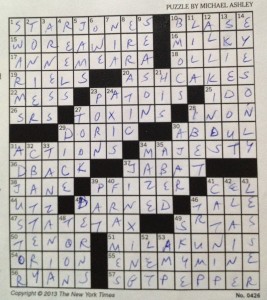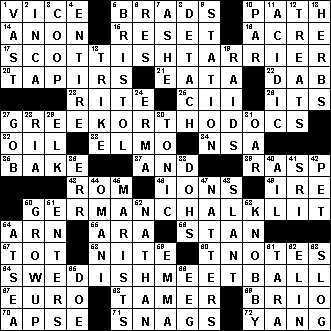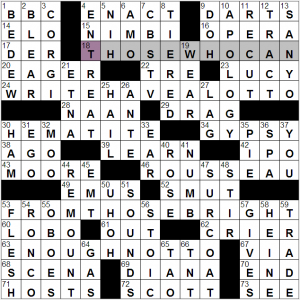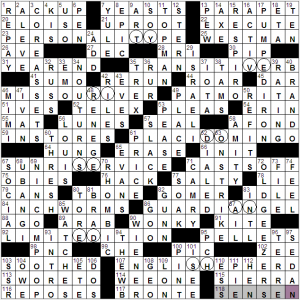NYT 7ish minutes
LAT 6:07 (Gareth)
CHE 9:26 (pannonica)
WSJ (Friday) untimed (pannonica)
Michael Ashley’s New York Times crossword
This was the final puzzle at the Marbles crossword tournaments last weekend. Solid puzzle, with a few spots that snarled our Chicago finalists:
- 12d. [What it often takes, it’s said], ALL KINDS. I started out with A VILLAGE, and so did two or three of our finalists, I think.
- 13d. [Hit a lazy pop-up, say], SKIED OUT. I’ve never seen that term. Like the finalists, I initially had FLIED OUT. Note that 12d and 13d are right next to each other and you’ve got a morass of bubbling tar.
- 20a. [Some cornbreads], ASH CAKES. Mmm, ashes. Apparently you plop your patty of bread dough right on the ashes of a campfire, let it bake, and then brush off the ashes? This is insane.
- 3d. [Marshal Dillon portrayer], ARNESS. Kids these days! Not everyone has any idea who James Arness is, and it’s not as if Arness is a really common, inferrable last name if you don’t know this guy. If you’ve forgotten whether 19a: [Cash in Cambodia] is RIELS or RIALS, you gotta know James Arness.
- 39a. [Viagra maker], PFIZER. Not spelled PHIZER, no, sir.
- 22a. [Base fare], MESS, not MRES.
- 9d. [TV set?], tricky clue for a SEASON of TV shows. With the second S coming from ASH CAKES, some of our Chicago finalists had a persistent blank there.
- 30d. [“Wearing the face that she keeps in ___ by the door” (Beatles lyric)], A JAR. One of our finalists had some blanks in that one. Again: Kids these days! Get off my lawn.
I appreciated the Scrabbliness and pop-culturiness of this puzzle. We’ve got three people’s full names: STAR JONES (a sign, perhaps, that this puzzle was constructed eons ago—Jones left The View nearly 7 years ago and hasn’t had nearly as prominent or long-term a TV gig since, and why would you put a now-just-a-footnote celeb at 1-Across?), ANNE MEARA (who is great, but does anyone think she’d be in puzzles this much without that cvvcv last name?), MILA KUNIS. Two fictional creations: SGT. PEPPER and the movie ENEMY MINE. We’ve got Scrabbleosity, including JINXING, TOXINS, MAJESTY, JAMS, and TANZANIA.
I can’t say I’ve ever seen that [Professional claims examiner] spelled ADJUSTOR rather than claims ADJUSTER. One dictionary shows me -er; the other has -er but says “also adjustor.”
11d. [Lee of silent films], LILA? Darn it, I’m not up on people whose movie careers began 95 years ago. Interestingly, her final movie, Cottonpickin’ Chickenpickers, came out in 1967 and not in the 1930s.
3.75 stars.
Jim Holland’s Los Angeles Times crossword — Gareth’s review
The theme is puns whose first word is the adjectival form of a European country. The second and fourth answers are homophonic, the first and third change the vowel sound. The answers are:
- 17a,[One lingering in Edinburgh?],SCOTTISHTARRIER.
- 27a,[Some Athenian physicians??],GREEKORTHODOCS. That’s a great pun!
- 50a,[Berlin sidewalk writing?],GERMANCHALKLIT. That’s also a clever one!
- 17a,[Fancy singles event in Stockholm?],SWEDISHMEETBALL
Otherwise, we have a typical all-long-theme-answers grid. Not much in the way of long splashy answers, BRISTOL maybe? Who else started at 1a at [___ Squad] and went “bomb? riot? Better wait for crossers…” TAPIRS are apparently [Hoglike], despite being perissodactyls… Lastly, I can foresee the names in the bottom-right giving some people trouble: I didn’t know the particular YANG and TARA, but they were inferrable enough. If someone managed to avoid knowing Tiger’s ex ELIN then it could be a bit harder…
Overall, some nice puns. Not much else. 3 Stars.
Jacob Stulberg’s Chronicle of Higher Education crossword, “Pen’s Tip” — pannonica’s write-up
It’s a quote theme. 18a [Start of a “grook” (an aphoristic poem) by Danish scientist Piet Hein]. Well, that didn’t mean much to me while solving, but now I have the luxury of looking it up (at Wikipedia, the easiest place to go). Turns out that Hein is the inventor of the gruk and the primary, if not only exponent of the form.
18a/24a/39a/53a/63a: THOSE WHO CAN | WRITE HAVE A LOT TO | LEARN | FROM THOSE BRIGHT | ENOUGH NOT TO.
It’s a sentiment I’ve seen often enough and this is a nifty, concise restatement of it (did Hein write this one in Danish or English?). Couldn’t really get a foothold on the grook, which impacted my solving time. Much of the difficulty, I think, came from having trouble parsing it, especially with the way it was broken up (e.g., the segments ending in LOTTO and NOTTO).
Don’t see much of a connection between title (“Pen’s Tip”) and theme, aside from the notion of advice.
- The lower left corner was recalcitrant, mostly because I couldn’t for the life of me retrieve from memory the answer to 44d [Change a jewel’s setting] RE–––––; couldn’t dislodge the too-short RESEAT from my mind. REMOUNT. Also, it didn’t help that I’d filled in GINSU at 54d [Maker of Six Star knives] RONCO.
- Lovely, erudite long non-theme answers: HEMATITE, Jean-Jacques ROUSSEAU [Bitter rival of Diderot]*, ENTREAT, and the new-to-me SURCOAT [Garment worn over a knight’s armor].
* Just picked up a slipcased Folio Society edition of Denis Diderot’s La Religieuse (The Nun)—with some risqué lithograph illustrations by Charles Mozley. One of the many weird and/or wonderful things obtained from my county library’s annual book drive and book sale, which is a pretty big operation, drawing dealers, collectors, and shoppers from a wide radius. - 58d [“Die Lotosblome” poet] Heinrich HEINE. Reminiscent of the theme’s Hein.
- 15a [Low clouds] NIMBI. Have never seen them, especially in my backyard.
- Was further hampered getting the quote by having RAIN for HAIL [Heavy weather?] at 25d.
- Classic Higher Education vibe™ clue for the mundane EAR [“The avenue to the heart,” per Voltaire]. Wonder if this came from the constructor or the editor. Ditto 37d [First word of “The Adventures of Huckleberry Finn”] YOU. Does Patrick Berry have vast earmarked stores of such literate contexts for humble words?
- 64d [Dentist’s need] GAS. Seems archaic.
Good puzzle, but kind of tough and dry.
Alice Long’s (pseudonym of editor Mike Shenk) Wall Street Journal crossword, “Double-Crossers” — pannonica’s write-up
The longest across answers are two-word phrases in which the last two letters of the first are repeated as the first two of the second. The twist is that the puzzle telescopes the phrases down, letting those bigrams overlap. Or, to think of it another way, those double letters double up. I’ve circled the relevant squares in the grid.
- 23a. [Extrovert, for one, to a double-crosser] PERSONALITYPE.
- 35a. [“To double-cross,” e.g., to a double-crosser] TRANSITIVERB.
- 46a. [Bismark and Pierre are on it …] MISSOURIVER.
- 61a. [Opera singer with nine Grammys …] PLACIDOMINGO.
- 67a. [Easter morning rite …] SUNRISERVICE.
- 86a. [Personal protector …] GUARDIANGEL.
- 92a. [Valuable volume …] LIMITEDITION.
- 107a. [Border collie’s look-alike …] ENGLISHEPHERD. Not all that well-known a breed in the US, since they don’t have AKC recognition (yet).
Lots of juicy longfill strewn about the grid: INCHWORMS, full-name PAT MORITA, CORE ASSETS, PUMPED IRON, NO U-TURNS, NINCOMPOOP, and OLD GEEZERS.
Unfamiliar to me: 25a [Celt, to a Viking] WESTMAN; 118a [Licorice-flavored breath freshener] SEN-SEN (apparently they resemble Vigroids, which sound like something you wouldn’t want to come down with).
Favorite clues: 12d [Bark back] STERN, 91a [It’s like a diamond in the sky] KITE (see also 70d [Like a diamond] RHOMBIC); 96d [Home of les astronautes] TERRE, it’s odd but it works.
Good but rather nondescript puzzle.




I had the completely opposite feeling about the puzzle.
Building on the discussion theme from yesterday, here’s a breakdown:
5 “I give you the movie/TV show/role, you give me the actor/actress clues” (or visa-versa)
2 give me the first name of the actor/actress clues
1 fill in the blank TV show clue
2 more animated character/TV clues
1 more Hollywood father/daughter pair clue
1 singer/song pair clue
1 more song clue (SGTPEPPER)
Of all of the above, only TOON and SGTPEPPER have interesting clues, unless you like the Hollywood trivia.
I don’t object to any individual entry. This would be a very nice puzzle with 1/2 or 1/3 of the above entries.
I endorse and applaud Jason F’s remarks, and was going to post remarkably similar thoughts, some of them almost verbatim. In my rant of yesterday, I deplored my perception that even purportedly themeless puzzles are covertly and surreptitiously themed to “Rock music and People and TV Guide magazines.” I tentatively excepted or exempted NYT Fri. and Sat. puzzles from that characterization. Today’s NYT inclines me to withdraw that exception. I would point to 1, 17, 30, 38, 51, 55, 56, and 57a; and 3, 7, 11, 30 and 45d. Basically the same list offered by Amy with a different emoticon.
I don’t mean to suggest that all of these are obscure, difficult, or that any one is individually objectionable. It is true that this was by far my least favorite Fri. or Sat. NYT of the year, but this is not my principal point. My point is first, that puzzles such as this are disproportionately focussed on a narrow, limited topic, reasonably summarized as “pop culture,” sufficient to label that topic a “theme” of the puzzle; and second, that this narrow, obsessive focus is so pervasive in so many puzzles that it is no longer perceived as the narrow focus, and limited theme that it is.
Admittedly, the word “disproportionate” is tricky. In proportion to what? I guess my answer is “in proportion to everything else.” All that there is. Everything that makes this universe an interesting, if annoying place to live. “Pop culture” is not excluded from that, but it is a minuscule fraction of the totality.
If the majority of solvers do not object to pop culture crossword content (and indeed may enjoy it), might the “narrow, obsessive focus” label not instead be laid on the high-culture buffs?
I think the point of both Jason’s and Bruce’s posts are not the pop culture clues, per se, but rather the preponderance of such clues within one puzzle. It’s kind of like your rule of fourteen regarding proper names and, as such, is a difficult thing to argue.
You may be right that the “majority of solvers don’t object to pop cultural crossword content’ but I doubt the same can be said for cramming a single puzzle with them. Too many of any particular topic can be frustrating. I can’t say whether or not pop cultural references are becoming more ubiquitous across the crossword world, although it does seem to be the case with younger constructors.
Personally, I don’t care if it’s high culture or pop. As long as I know the answer, I’m a happy solver.
Amy I’m not suggesting a narrow obsessive focus on that either, especially within a general, purportedly themeless puzzle.
It’s in the definition: “popular culture”. Makes sense Will would take puzzles that have a lot of stuff that is “popular” since that’s how to appeal to the largest possible audience…
(What I can’t figure out is how this was my fastest Friday of the year despite the amount of stuff I DIDN’T know…)
It’s a tough balance an editor needs to strike. The demographics of crossword solvers are certainly not the same as the overall population, even though there are solvers from all walks of life. Crossword solvers do tend to skew older and (I believe) female. An editor can’t alienate the main demographic but needs to keep crosswords interesting for younger solvers, or crosswords will fade into irrelevancy. That seems to me like an awfully tricky tightrope, and it’s a big reason we have to keep having these discussions.
NYT: Looking back, it seems like a solid puzzle, and definitely scrabbly. But it did not make my heart sing, for some reason. Especially the NW felt like I was solving a puzzle from an old TV guide (does that publication still exist?).
Is “WORE A WIRE” a stand alone phrase?
Man, I flew through this (relative to my typical times, I think this was 2*Orange effort), my only hang-up was that upper right with FLIED for SKIED. I thought maybe opals were MINED as well. LILA was no help, but ALL KINDS and EYES ONLY fell and the rest is history.
I sorta agree with Huda on “wore a wire.” Would “wore socks” be an acceptable entry?
I have to agree with Bruce on all the pop culture clues. They seem to be taking over from all the sports clues I used to complain about so bitterly. Is that the general knowledge everyone should share?
I have to go see if Cottonpickin’ Chickenpickers is on Netflix. Somehow I missed it when it came out.
SKIED OUT should not have been clued as a baseball clue at all. If it is clued as a baseball clue, I would not include the word “lazy”–“towering” would be far more appropriate. First major lapse in the idiom of sports in quite a while.
I do not know if it would be too little known, but I would have clued SKIED OUT as terrain on a slope that had gotten bare from overuse.
I enjoyed the discussion yesterday. I find it funny in a way that Bruce, whose strength–classical music–is my weakness, finds the puzzles lacking. I personally wish there were more sports, R&B, games and difficult vocabulary words.
My daughter loved The Suite Life of Zack and Cody and especially its sequel, The Suite Life on Deck. I find it interesting when the very pretty and chaste young female stars of these shows switch gears so to speak as Brenda Song did in The Social Network and Selena Gomez is doing. Fills me with great admiration for the always classy idol of my prepubescent youth, Annette Funicello.
Steve
And to think all this time I’ve believed ASHCAKES had something to do with Ash Wednesday…
Me too:)
A matter of fact:
For CHE 16-A, clued “Palais Garnier production,” the answer is OPERA. That was true until 1989, when the Paris Opera moved to the Opera Bastille. Today Palais Garnier is used primarily for ballet.
Good catch, Stephen.
In the context of the discussion we’re having regarding the puzzles, I was wondering what I’d tell Will if I were sitting next to him at a dinner party. Having tried my hand at some old puzzles, I would say I’m immensely grateful that he has updated both the content and the spirit of the puzzles—they are more fun, more playful, more adventurous and less self-consciously highbrow. The modern NYT puzzle attracts a younger generation of constructors and solvers. Yet, like the traditional puzzles, it continues to challenge the mind and show the many different ways that people love this language. For all of this, Bravo!
I also think that the world of crosswords has helped me get away from the idea that there is a certain fund of knowledge that any self-respecting, aware, educated person, should have. I don’t know if this is a framework that you might have Bruce, but I certainly had it based on my French education. However, the explosion of information, some of it real knowledge, some of it trivial facts and factoids, makes it impossible to agree on the essential shared knowledge for our modern civilization. Even within my own subfield of science, I have given up on knowing all there is to know. Not possible. I know how to ask the questions, how to find the answers, how to frame issues, draw conclusions, and even how to generate new knowledge and make discoveries. But I cannot capture it all, as I was able to when I started in the field (and not because of my aging brain). So, I have changed my attitude, and don’t feel bad about simply having no clue about all kinds of stuff that people seem to know very well. I see it as a series of teachable moments.
But, back to Will, my dinner companion. I would add that, given all this, it might be good to ensure that each puzzle has some degree of breadth in content, as well as a balance of very specific knowledge (either you know it or you don’t variety) vs. knowledge of the language, the culture, or playful thought. And in that, I would echo the criticism of today’s puzzle that several of commenters have made. Some people will fly through it because it’s their area of expertise. And others will be left scratching their head because no amount of intelligence, experience or strategy can get you out of some of these corners if you do not know your entertainment personalities. That feels non-inclusive to many solvers, and therefore contrary to the spirit that Will has generally brought to the puzzle during his tenure.
Great post, huda! I hadn’t seen it when I posted a few minutes later, but I’ve come to a somewhat similar conclusion re a necessary body of knowledge, and I think you’ve done an excellent job of describing the shortcomings of today’s NYT puzzle.
Interesting, thoughtful, provocative comments, Huda. I too am immensely grateful to WS for having essentially reinvented crosswords by injecting humor, wordplay, creativity, inventiveness, liveliness in what was an almost moribund art form at the time he ascended to his position. I particularly appreciated your last paragraph. We all owe him an immense debt of gratitude, which we often take for granted and overlook.
The question of whether there is a “canon” — a basic fund of knowledge which an educated, sophisticated person is expected to be conversant with — is one which has always interested me, independently of puzzles. Obviously there are no necessary or sufficient conditions, “An educated, sophisticated person will know . . . this;” or — “if you know . . .this you are an educated, sophisticated person.”
I would hope not to come across as snotty and elitist because I happen to be somewhat well versed in what some would consider a “high culture” area, but perhaps it’s too late for that hope. But to me, my musical interests are just a part of the ether, the atmosphere, something I have absorbed automatically, naturally, all my life. In other words, the same, subjectively and psychologically as knowing about rock bands and rappers. But your word “non-inclusive” hit home to me. That’s exactly summarizes my reaction. The message continually hammered home is “If you want to belong to our club, you have to know about these things. Otherwise, you’re an outsider; not one of us.” Obviously that’s rhetorically overstated for emphasis, but the point is what I intend.
I think my most fundamental objection remains unclear. It’s the surreptitious, insidious, I might go so far as to say dishonest, pretense that puzzles which are clearly themed and narrowly focused, are unthemed. I would be much happier if it were announced explicitly up front, “OK — here’s another pop culture puzzle.”
See paragraph 4 here:
http://www.cruciverb.com/index.php?action=ezportal;sa=page;p=16
It seems to me that there are quite a few clues/answers in the NYT that are not “pop culture,” but are also not just basic “understand the language” (assuming this means, basically, that you need “dictionary” or “thesaurus” type knowledge of the language). To wit:
“Like opals” = milky (science, geology)
“Cash in Cambodia” = riels (geography, economics)
“Some cornbreads” = ashcakes (cooking, rural culture)
“PCBs, e.g.” = toxins (science, chemistry)
“Kind of column” = Doric (architecture)
“Arizona player, for short” = D’Back (sports – maybe pop culture)
“Viagra maker” = Pfizer (just as much finance/economics as pop culture)
“Major education supporter” = state tax (finance/economics/politics)
“Rigel’s constellation” = Orion (science, astronomy, mythology)
“1940’s __ Pact” = Axis (history)
“Make mincemeat of, say” = dice (cooking)
“Land on the Indian Ocean” = Tanzania (geography)
“Mint family plant” = (science, botany)
“Lady of Arthurian legend” = (literature)
“___ terrier” = Skye (science, biology)
“Electrical unit” = amp (science, physics)
Now, the clues/answers that others here have classified as “pop culture” outnumber any classification above, but maybe that just means the “pop culture” classification is too broad. By my classification above, there are six “science” clues/answers – should we consider that a theme in this puzzle, too?
Overall, this strikes me as a fairly “balanced” puzzle, as defined in the guidelines Gareth references. A little light on art and (non-pop) music perhaps, but certainly requiring broad knowledge.
seahedges, I had the same thought about the Palais Garnier and OPERA.
And thanks, Jason and Bruce, for saying what I have so often thought. It’s not that I object to having clues about pop culture–heck, if I objected to every area in which I’m weak, there’d be almost nothing left. Rather, it’s what at times seems like an oppressive number of pop culture clues.
Yeah, I know. Lotsa puzzles around… But if you want to solve another themeless here ya go:
http://crosswordfiend.com/forum/viewtopic.php?f=14&t=1283
Thanks.
NYT was pop heavy which isn’t so bad once in a while I guess, but to stack Mila Kunis, Enemy Mine and Sgt. Pepper on top of each other is probably unfair.
Nitpick alert: Technically “toxins” refer to poisonous substances produced by plants or animals (e.g. rattlesnake venom). PCBs and other man-made poisons are “toxic chemicals.”